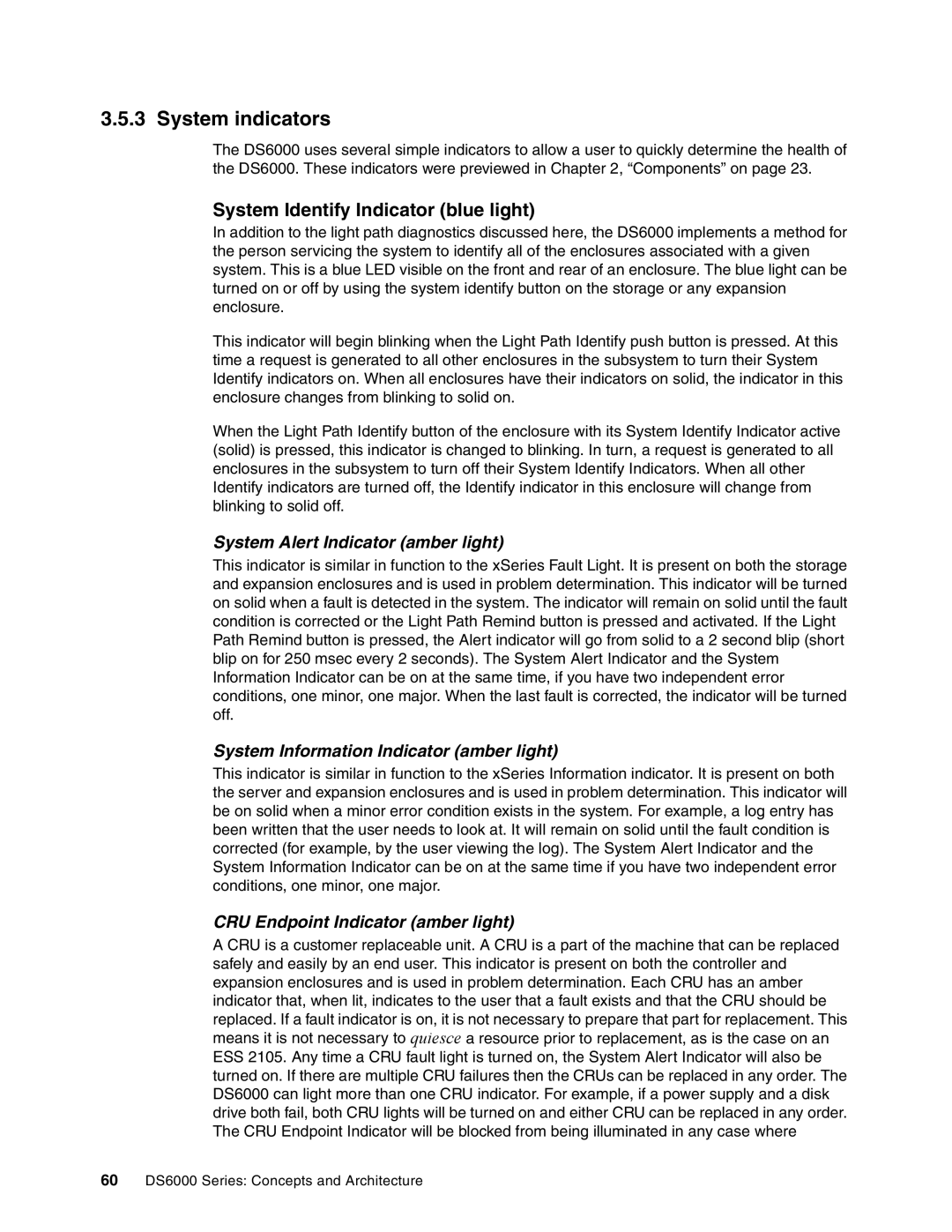3.5.3 System indicators
The DS6000 uses several simple indicators to allow a user to quickly determine the health of the DS6000. These indicators were previewed in Chapter 2, “Components” on page 23.
System Identify Indicator (blue light)
In addition to the light path diagnostics discussed here, the DS6000 implements a method for the person servicing the system to identify all of the enclosures associated with a given system. This is a blue LED visible on the front and rear of an enclosure. The blue light can be turned on or off by using the system identify button on the storage or any expansion enclosure.
This indicator will begin blinking when the Light Path Identify push button is pressed. At this time a request is generated to all other enclosures in the subsystem to turn their System Identify indicators on. When all enclosures have their indicators on solid, the indicator in this enclosure changes from blinking to solid on.
When the Light Path Identify button of the enclosure with its System Identify Indicator active (solid) is pressed, this indicator is changed to blinking. In turn, a request is generated to all enclosures in the subsystem to turn off their System Identify Indicators. When all other Identify indicators are turned off, the Identify indicator in this enclosure will change from blinking to solid off.
System Alert Indicator (amber light)
This indicator is similar in function to the xSeries Fault Light. It is present on both the storage and expansion enclosures and is used in problem determination. This indicator will be turned on solid when a fault is detected in the system. The indicator will remain on solid until the fault condition is corrected or the Light Path Remind button is pressed and activated. If the Light Path Remind button is pressed, the Alert indicator will go from solid to a 2 second blip (short blip on for 250 msec every 2 seconds). The System Alert Indicator and the System Information Indicator can be on at the same time, if you have two independent error conditions, one minor, one major. When the last fault is corrected, the indicator will be turned off.
System Information Indicator (amber light)
This indicator is similar in function to the xSeries Information indicator. It is present on both the server and expansion enclosures and is used in problem determination. This indicator will be on solid when a minor error condition exists in the system. For example, a log entry has been written that the user needs to look at. It will remain on solid until the fault condition is corrected (for example, by the user viewing the log). The System Alert Indicator and the System Information Indicator can be on at the same time if you have two independent error conditions, one minor, one major.
CRU Endpoint Indicator (amber light)
A CRU is a customer replaceable unit. A CRU is a part of the machine that can be replaced safely and easily by an end user. This indicator is present on both the controller and expansion enclosures and is used in problem determination. Each CRU has an amber indicator that, when lit, indicates to the user that a fault exists and that the CRU should be
replaced. If a fault indicator is on, it is not necessary to prepare that part for replacement. This means it is not necessary to quiesce a resource prior to replacement, as is the case on an
ESS 2105. Any time a CRU fault light is turned on, the System Alert Indicator will also be turned on. If there are multiple CRU failures then the CRUs can be replaced in any order. The DS6000 can light more than one CRU indicator. For example, if a power supply and a disk drive both fail, both CRU lights will be turned on and either CRU can be replaced in any order. The CRU Endpoint Indicator will be blocked from being illuminated in any case where
60DS6000 Series: Concepts and Architecture
